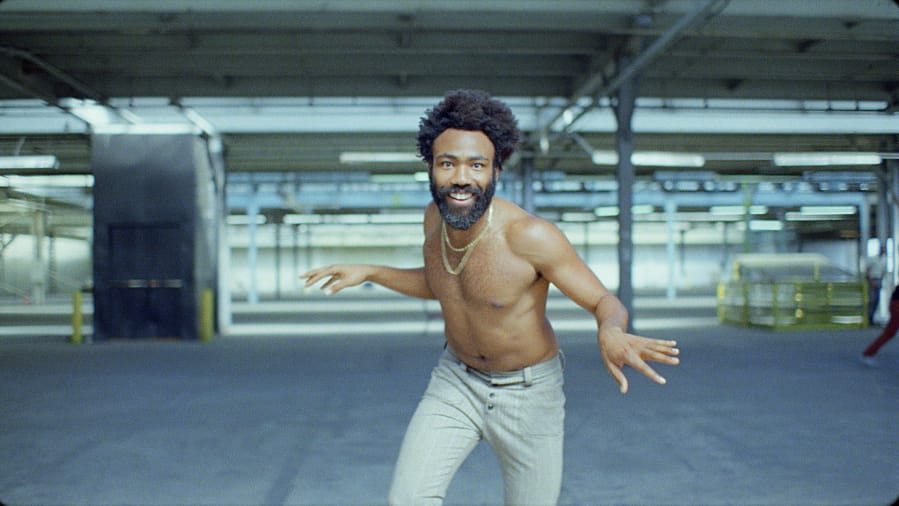Donald Glover didn’t hold back when creating the music video for “This Is America,” the most recent single by his rapper alter-ego, Childish Gambino. He didn’t have to.
As its name suggests, the video is emblematic of its time — blatantly political in a way that appeals to social media and its love of dissectable visuals. Consider Glover’s dancing, presumably choreographed to mimic a minstrel character; the murder of choir singers, evoking the Charleston church massacre; and death riding in on a white horse.
Political edge isn’t a new addition to the art form by any means, but it’s difficult to imagine the recent deluge of videos exploring racial and sexual identity occurring in the MTV era. Beyonce’s visual album “Lemonade” kicked off a recent wave with its emotionally hefty exploration of black womanhood, followed by similarly bold videos by Frank Ocean, Janelle Monae, Glover and others. The phenomenon is, in part, the result of political trends such as polarization and identity politics rising to the forefront of online conversation, and movements such as Black Lives Matter and #MeToo asserting the equality of marginalized groups. But it also owes a lot to the YouTube revolution and the freedom that video platforms grant artists.
Just ask Larry Miller, director of the music business program at New York University’s Steinhardt School of Culture, Education and Human Development. In response to the question of whether the purpose of music videos has evolved over the years, he chuckled.
“I’m only laughing out loud because yes, of course,” he said. “At one time, the purpose of music videos was to sell albums.”
MTV, the first-ever channel dedicated to music videos, took off after its 1981 launch, and record labels used it as a promotional mechanism for new music. The buzz surrounding videos such as Madonna’s “Like a Prayer,” a Vatican-condemned commentary on race and religion, and Michael Jackson’s “Thriller,” viewed as a metaphor for sexual awakening, reminded viewers to head out and buy albums.
Television also meant advertising dollars, which translated to enormous budgets for the videos. But, sometimes, the money meant sacrificing creative control. The more that was at stake, according to several directors, the safer labels played it. Strict TV guidelines didn’t make things any easier.
Those who worked on Monae’s “Dirty Computer” got a taste of this when preparing a version of the accompanying short film to air on MTV and BET in April. Sexual liberation is a theme throughout the album, especially in songs such as “Pynk.” Director Emma Westenberg made sure its video, which references female anatomy through elements like Monae’s so-called vagina pants, reflected that.
“The imagery, because the song is so open and free, was so much fun to develop,” she said. “It’s already so clear what (‘Pynk’) is about that the imagery came from the lyrics.”
The “Dirty Computer” that aired on television was quite different from its online counterpart, according to Andrew Donoho. He co-directed the narrative portion and said the team had to cut shots that included nudity and stuck-up middle fingers. They even eliminated a “too long and controversial” bit of “Pynk” that featured poetry Monae read to her on-screen love interest, played by Tessa Thompson.
“It’s definitely something that can only exist in the here and now,” Donoho said of the online cut. “There were plenty of artists in the ’80s and ’90s that would have loved to make controversial pieces or videos that pushed boundaries, but censorship and having to cater to TV networks and labels and go through all the hands and politics, I’m sure there’s a lot of art that never got made.”
“Dirty Computer” shares this “here and now” quality with Frank Ocean’s videos, especially the one for his single “Nikes.” It critiques hedonistic pleasure by contrasting shallow joy (shots of money and the titular shoes) with harsh realities (photographs of Trayvon Martin and late hip-hop artists). Dueling voices — Ocean’s and a higher-pitched version — mimic this juxtaposition, and his androgynous style along with glittery and angel-winged bodies add sexual fluidity to the conversation. (In 2012, Ocean announced on Tumblr that he fell in love with a man at 19.)
Such videos feed our culture’s demand for art shaped by politics in today’s antagonistic environment, where the stakes feel particularly high for both sides of every culture war. Music videos help artists clearly define where they stand on issues such as gun violence and race relations, and Westenberg hopes this strong messaging can influence public opinion, too. She received some homophobic feedback about “Dirty Computer” in an Instagram comment but still thinks the film’s celebratory feel has the ability to “change some people’s views.”
YouTube is ideal for this kind of video. It emerged as a new platform for artistic expression in 2005, ending what director Andrew Thomas Huang called the “dark period” after MTV pivoted to reality programming in the late 1990s and early 2000s.
Zia Anger, who has directed videos for Mitski and Angel Olsen, said YouTube makes it easy to figure out exactly what fans want, giving artists a more personalized look at their base.
“There’s a certain amount of visibility involved with seeing a viewer on YouTube,” since everyone can see viewer figures and comments, Anger said. “I guess there were Nielsen ratings for MTV back in the day, but this … is a totally different beast.”
The ad money from the MTV era has vanished, with video budgets dropping from as high as the millions to the $50,000-100,000 range, according to Kate Miller, senior vice president of visual content at Republic Records. But technology has become cheaper and more efficient.
“These days, with the advent of online, the power really is in the artists’ hands,” said Devin Sarno, vice president of creative services at Warner Brothers Records. “They can put out a piece of content whenever they want,” and at whatever length they want.



